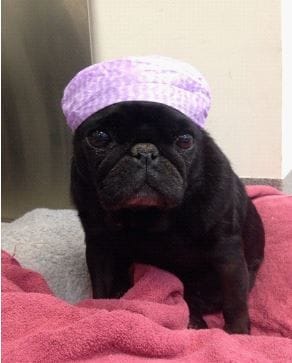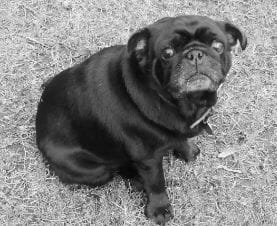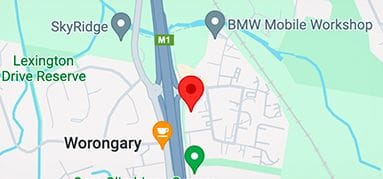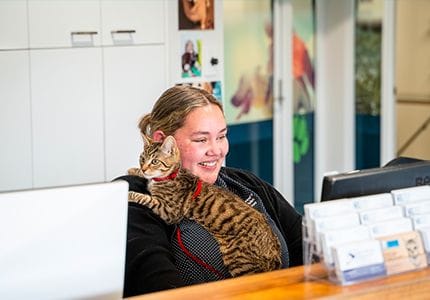Other conditions such as hiatal hernia, gastric reflux, tracheal collapse, bronchial collapse, pharyngeal hyperplasia and cardiac disease secondary to increased pulmonary resistance may also occur - especially if corrective treatment is delayed. We find if the primary problems are addressed at an early age (ideally less than 2 years old) then we see less secondary changes, animals usually require less complicated surgical procedures, and long term outcomes are improved. Thus, early intervention is strongly recommended.
Dogs with brachycephalic airway syndrome usually have a history of noisy breathing, snoring, poor exercise tolerance which worsens in hot, humid weather. Some dogs will also vomit or gag when swallowing. Episodes of cyanosis (blue tongue and gums from lack of oxygen) and collapse can occur at times of excitement or stress in some dogs. Being overweight tends to worsen the problems.
Stenotic nares can be easily diagnosed on physical examination however definitive diagnosis of the other aspects of brachycephalic airway syndrome requires visual assessment under anaesthesia.
Do all brachycephalic animals require corrective surgery? In our experience over many years of treating these dogs and cats over 95% of the animals we see significantly benefit from surgery. They are more comfortable following surgery, breathe more easily and are more active.
Our routine assessment of brachycephalic dogs involves:
- Blood tests to assess animal’s general health and screen for any other issues.
- Chest x-ray or CT to assess the trachea, lungs and thorax. We also assess for the presence of hemi vertebrae - abnormal vertebrae are common in some of the brachycephalic breeds.
- Patients are then pre-oxygenated - given 100% oxygen for 10 minutes prior to anaesthesia
- Patients are then anaesthetised to allow assessment of the airways. We examine the soft palate, tonsils, larynx, laryngeal function, choanae and pass a small bronchoscope into the upper and lower airways.
Treatment:
Following assessment, we prefer to proceed with surgical correction of any abnormalities present at this time under the same anaesthetic. The elongated soft palate, everted laryngeal ventricles and tonsils are assessed and treated as appropriate. Stenotic nares are also opened / widened. There are many different surgical procedures and your surgeon will discuss these with you. The exact procedures may not be able to be determined until the patient has been assessed. The goal of surgery is to improve airflow.
Complications:
With any surgical procedure complications are possible. There is a small risk with any anaesthetic, as there is in people. The chance of a major anaesthetic complication is very low - only 0.01%.
Patients are monitored very closely immediately after surgery. At VSS all our brachycephalic patients are transferred to ICU for recovery. Our ICU is staffed by experienced clinicians and nurses 24 hours per day. Patients are usually observed in the hospital for at least 24 hours. Post-operative coughing and gagging are common. In some cases, significant post-operative inflammation or bleeding can obstruct the airway, making breathing difficult or impossible. Our initial approach is to re-anaesthetise the patient and pack the pharynx with swabs soaked in hyper osmotic solution to help reduce the swelling, this resolves the issue in most cases. Occasionally, if the swelling does not resolve, a tube must be placed and maintained through a small incision in the neck into the trachea (temporary tracheostomy) until the swelling in the pharynx subsides enough that the patient can breathe normally. This can take 2-3 days. This happens in a small number of cases - and is typically related to the severity of the condition - but does this add significantly to the care required for the patient.
In very severe cases addressing the upper airway issues may not be adequate and the creation of a new permanent opening into the trachea in the neck area (called a permanent tracheostomy) may be the only solution, there are significant complications associated with this procedure. A permanent tracheostomy is required in less than 1% of cases.
The prognosis is good for young animals. They generally will breathe much more easily and with significantly reduced respiratory distress. Their activity level can markedly improve. Older animals may have a less favourable prognosis, especially if the process of laryngeal collapse has already started. If the laryngeal collapse is advanced, the prognosis is poor.
&geometry(278x56))








